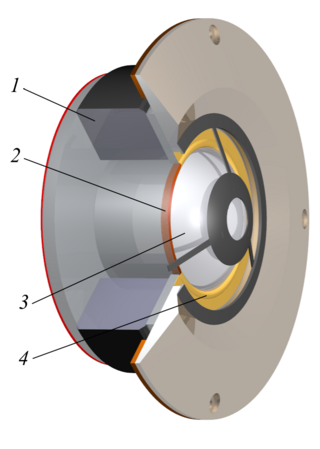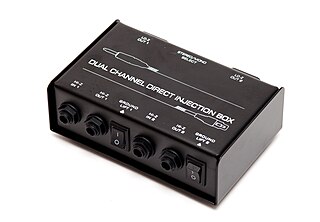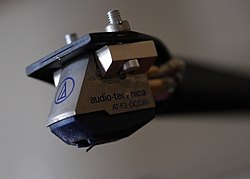
A loudspeaker is an electroacoustic transducer that converts an electrical audio signal into a corresponding sound. A speaker system, also often simply referred to as a speaker or loudspeaker, comprises one or more such speaker drivers, an enclosure, and electrical connections possibly including a crossover network. The speaker driver can be viewed as a linear motor attached to a diaphragm which couples that motor's movement to motion of air, that is, sound. An audio signal, typically from a microphone, recording, or radio broadcast, is amplified electronically to a power level capable of driving that motor in order to reproduce the sound corresponding to the original unamplified electronic signal. This is thus the opposite function to the microphone; indeed the dynamic speaker driver, by far the most common type, is a linear motor in the same basic configuration as the dynamic microphone which uses such a motor in reverse, as a generator.

A microphone, colloquially called a mic, or mike, is a transducer that converts sound into an electrical signal. Microphones are used in many applications such as telephones, hearing aids, public address systems for concert halls and public events, motion picture production, live and recorded audio engineering, sound recording, two-way radios, megaphones, and radio and television broadcasting. They are also used in computers and other electronic devices, such as mobile phones, for recording sounds, speech recognition, VoIP, and other purposes, such as ultrasonic sensors or knock sensors.

A tweeter or treble speaker is a special type of loudspeaker that is designed to produce high audio frequencies, typically deliver high frequencies up to 100 kHz. The name is derived from the high pitched sounds made by some birds (tweets), especially in contrast to the low woofs made by many dogs, after which low-frequency drivers are named (woofers).

A guitar amplifier is an electronic device or system that strengthens the electrical signal from a pickup on an electric guitar, bass guitar, or acoustic guitar so that it can produce sound through one or more loudspeakers, which are typically housed in a wooden cabinet. A guitar amplifier may be a standalone wood or metal cabinet that contains only the power amplifier circuits, requiring the use of a separate speaker cabinet–or it may be a "combo" amplifier, which contains both the amplifier and one or more speakers in a wooden cabinet. There is a wide range of sizes and power ratings for guitar amplifiers, from small, lightweight "practice amplifiers" with a single 6-inch speaker and a 10-watt amp to heavy combo amps with four 10-inch or four 12-inch speakers and a 100-watt amplifier, which are loud enough to use in a nightclub or bar performance.

A preamplifier, also known as a preamp, is an electronic amplifier that converts a weak electrical signal into an output signal strong enough to be noise-tolerant and strong enough for further processing, or for sending to a power amplifier and a loudspeaker. Without this, the final signal would be noisy or distorted. They are typically used to amplify signals from analog sensors such as microphones and pickups. Because of this, the preamplifier is often placed close to the sensor to reduce the effects of noise and interference.

A DI unit is an electronic device typically used in recording studios and in sound reinforcement systems to connect a high output impedance unbalanced output signal to a low-impedance, microphone level, balanced input, usually via an XLR connector and XLR cable. DIs are frequently used to connect an electric guitar or electric bass to a mixing console's microphone input jack. The DI performs level matching, balancing, and either active buffering or passive impedance matching/impedance bridging. DI units are typically metal boxes with input and output jacks and, for more expensive units, “ground lift” and attenuator switches.
Line level is the specified strength of an audio signal used to transmit analog audio between components such as CD and DVD players, television sets, audio amplifiers, and mixing consoles.
PS Audio is an American company specializing in high-fidelity audio components equipment for audiophiles and the sound recording industry. It currently produces audio amplifiers, preamplifiers, power related products, digital-to-analog converters, streaming audio, music management software and cables.

A pickup is a transducer that captures or senses mechanical vibrations produced by musical instruments, particularly stringed instruments such as the electric guitar, and converts these to an electrical signal that is amplified using an instrument amplifier to produce musical sounds through a loudspeaker in a speaker enclosure. The signal from a pickup can also be recorded directly.
Roksan is a British manufacturer of high fidelity audio products for domestic use, based in Rayleigh, Essex. It is best known for its influential and innovative design for hi-fi equipment, and in particular its Xerxes platform for playing LP records.

RIAA equalization is a specification for the recording and playback of phonograph records, established by the Recording Industry Association of America (RIAA). The purposes of the equalization are to permit greater recording times, to improve sound quality, and to reduce the groove damage that would otherwise arise during playback.
Musical Fidelity is a British producer of high-end audio equipment focusing on streaming music players, and its core product range of amplifiers of various types. Other products have included headphones, Digital-Analog Converters (DACs), CD players, Bluetooth Receivers, ‘all-in-one systems’. Founded in the United Kingdom in 1982, they are known for their unusual industrial design, Nuvistor tube use and Class-AB amplifiers.
Stanton Magnetics, doing business as Stanton, is a business unit of inMusic Brands that designs and markets turntables, cartridges, DJ mixers, DJ media players, and DJ controllers.

A bass amplifier is a musical instrument electronic device that uses electrical power to make lower-pitched instruments such as the bass guitar or double bass loud enough to be heard by the performers and audience. Bass amps typically consist of a preamplifier, tone controls, a power amplifier and one or more loudspeakers ("drivers") in a cabinet.
Phono input is a set of input jacks, usually mini jacks or RCA connectors, located on the rear panel of a preamp, mixer or amplifier, especially on early radio sets, to which a phonograph or turntable is attached.

Ortofon is a Danish manufacturer of electronic audio equipment. It is the world's largest producer of magnetic cartridges for phonograph turntables, with 500,000 cartridges sold annually.
Record restoration, a particular kind of audio restoration, is the process of converting the analog signal stored on gramophone records into digital audio files that can then be edited with computer software and eventually stored on a hard-drive, recorded to digital tape, or burned to a CD or DVD. The process may be divided into several separate steps performed in the following order:
- Cleaning the record, to prevent unwanted audio artifacts from being introduced in the capture that will necessitate correction in the digital domain, and to prevent unnecessary wear and damage to the stylus used in playback.
- Transcription of the record to another format on another medium ;
- Processing the raw sound file with software in order to remove transient noise resulting from record surface damage ;
- Using software to adjust the volume and equalization;
- Processing the audio with digital and analogue techniques to reduce surface/wideband noise;
- Saving the file in the desired format.

The Technics SL-10 is a direct-drive, linear tracking automatic turntable, which was produced from 1979 to 1985.
Denon DL103 is an MC phono cartridge made by DENON company.

The NAD 3020 is a stereo integrated amplifier by NAD Electronics, considered to be one of the most important components in the history of high fidelity audio. Launched in 1978, this highly affordable product delivered a good quality sound, which acquired a reputation as an audiophile amplifier of exceptional value. By 1998, the NAD 3020 had become the most well known and best-selling audio amplifier in history.













